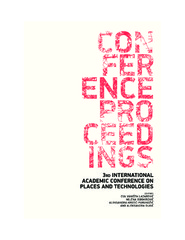| dc.creator | Cvetković, Marija | |
| dc.creator | Vaništa Lazarević, Eva | |
| dc.date.accessioned | 2020-03-10T12:56:58Z | |
| dc.date.available | 2020-03-10T12:56:58Z | |
| dc.date.issued | 2016 | |
| dc.identifier.isbn | 978-86-7924-161-0 | |
| dc.identifier.uri | https://raf.arh.bg.ac.rs/handle/123456789/496 | |
| dc.description.abstract | In shopping malls, which lately have become one of the basic characteristics of cities, behavior
and interactions are defined by the primary purpose of this space - consumption. Potential
interactions are reduced to temporary, superficial formal communication. Simulation of city
streets with shops and small squares, where cafés are covered by the roof of the shopping mall,
takes over the role which downtown had, until recently. This paper is presenting in which ways
shopping malls may simulate the city center to legitimize itself as a public space. How do
shopping “cities” transform relationship of internal and external, public and private space? The
paper aims to explore the ways in which the inner space of these centers dictates behavior of
visitors and shape the way they spend their free time. What is the new image of the city that these
centers create? It examines the issue of sustainability of architectural objects in addition to its
primary function; at the same time can have a strong position in the communication, representing
the tools of communication and carries the meaning in the service of consumption, marketing,
promotion and spectacle. The role of cultural space of the mall, as a quasi-space is explored with
the case study method of two dominant shopping malls in Belgrade. The study refers to dominant
phenomena in architecture, which is the result of the influence of classic consumption power. The
goal of the paper is to access important issue of different representation of an architectural
experience in reality in relation to the experience of architecture through the mass media. | en |
| dc.language.iso | en | sr |
| dc.publisher | Belgrade : University of Belgrade - Faculty of Architecture | sr |
| dc.rights | openAccess | sr |
| dc.subject | Shopping mall | sr |
| dc.subject | Identity | sr |
| dc.subject | Marketing | sr |
| dc.subject | Semi-public space | sr |
| dc.subject | Belgrade | sr |
| dc.title | The image of the city vs. semi-public spaces of shopping malls: case study of Belgrade | en |
| dc.type | conferenceObject | sr |
| dc.rights.license | ARR | sr |
| dcterms.abstract | Цветковић, Марија; Ваништа Лазаревић, Ева; | |
| dc.citation.spage | 481 | |
| dc.citation.epage | 487 | |
| dc.identifier.fulltext | https://raf.arh.bg.ac.rs/bitstream/id/1245/bitstream_1245.pdf | |
| dc.identifier.rcub | https://hdl.handle.net/21.15107/rcub_raf_496 | |
| dc.type.version | publishedVersion | sr |

